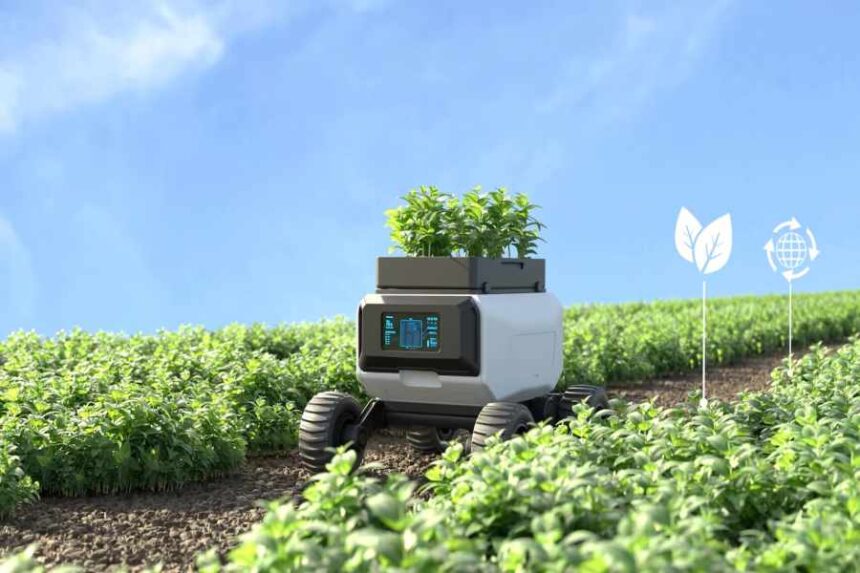Have you ever wondered how the food you eat gets from the farm to your table so quickly and efficiently? Farming has changed a lot in recent years. Technology has become a big part of agriculture, making the work easier and more productive. One of the most exciting changes is the use of robotics. These machines help farmers do their jobs faster, more safely, and with better results. As farms grow in size and demand increases, robots step in to handle tasks that once took a long time.
In this blog, we will share how robotics plays a key role in making farming processes smoother, faster, and smarter.
Understanding Robotics in Agriculture
Robotics in agriculture refers to using machines and technology to perform tasks that people used to do by hand. These machines can plant seeds, water crops, and even harvest produce. Robotics helps farmers save time, use fewer resources, and reduce the amount of hard labor. As a result, farmers can focus more on managing their land and making smart decisions for their crops. Robotics does not replace farmers—it supports them.
Modern farms use different kinds of robots. Some are tractors that drive themselves. Others are small drones that fly above fields and check plant health. Some robots can move through rows of crops and remove weeds or pick fruits. These machines are smart and often use sensors and cameras to understand the farm environment. When used the right way, they help farmers work faster and grow more food.
How Automation Boosts Productivity
Robotic automation helps farmers get more done in less time. It can be hard for a small team to manage large fields. With robots, tasks like seeding, watering, and harvesting happen quickly and accurately. One helpful tool is the MBX Bucker. This machine speeds up the process of removing hemp flowers from their stalks. Instead of spending hours doing this by hand, farmers can use this tool and finish the task much faster. It makes their work smoother and less tiring.
Robots also make fewer mistakes than humans during repeated tasks. For example, robots can plant seeds at the right depth and distance every time. They don’t get tired, and their work is more consistent. This helps crops grow evenly, which can lead to better harvests. By using automation tools, farms can increase their output and meet the growing demand for food and plants.
Reducing Labor Shortages and Physical Strain
Many farms today have trouble finding enough workers. Farming is hard work, and fewer people want to do jobs that involve long hours outdoors. Robots can help solve this problem by doing some of the hardest tasks. For example, harvesting, weeding, and spraying can be done by machines. This reduces the need for many hands in the field and helps farms run smoothly even with fewer workers.
Robots also reduce the physical strain on human workers. Repetitive tasks like bending, lifting, or trimming can lead to injuries. When robots handle these jobs, workers are less likely to get hurt or tired. This creates a safer and healthier work environment. It also lets people focus on more important tasks like monitoring crop health and making business decisions.
Improving Precision and Efficiency
One of the biggest benefits of robotics in farming is precision. Robots use advanced sensors, GPS, and data tools to work more accurately than humans. They can water plants only when needed or apply fertilizer in exact amounts. This reduces waste and helps crops grow better. Precision farming helps farmers use resources wisely and avoid harming the environment.
Drones are a great example of this. They fly over fields and take pictures or gather data about plant health, soil moisture, and more. With this information, farmers can treat only the parts of the field that need help. This saves money, time, and materials. Robotic tools like precision seeders and sprayers help farmers make every move count, leading to higher-quality crops.
Harvesting Crops Faster and Better
Harvesting is one of the most important and time-consuming parts of farming. It often has to be done in a short window to keep crops fresh and prevent waste. Robots can help by picking fruits and vegetables quickly and gently. These machines are built with soft arms and special sensors to avoid damaging delicate produce like tomatoes or berries.
Robotic harvesters work day and night without getting tired. They can cover large fields quickly and keep up with growing demands. Some machines can even sort produce by size or quality as they pick, saving time during the packaging process. With the help of robots, farmers can harvest faster, reduce losses, and deliver fresher food to markets.
Helping with Crop Monitoring and Maintenance
Farming isn’t just about planting and harvesting. It’s also about taking care of crops every day. Robots play a big role in monitoring plant health and spotting problems early. For example, robots can detect pests or diseases before they spread. They use cameras, sensors, and even artificial intelligence to find issues that are hard to see with the human eye.
By catching problems early, farmers can act fast and protect their crops. Robots also help maintain fields by trimming plants, pulling weeds, and keeping soil in good condition. Some machines move between rows of crops and clean up weeds without using chemicals. This keeps the farm healthy and reduces the need for harmful sprays. These daily maintenance tasks help keep crops strong from start to finish.
Making Farming More Affordable Over Time
While robots can be expensive at first, they often save money in the long run. Once a robot is bought and set up, it can do work without needing a paycheck, breaks, or time off. This reduces labor costs and cuts down on mistakes. Over time, the money saved can be more than the money spent to buy the robot.
Also, robots last a long time and can be used across many seasons. With regular care, they become a trusted part of the farm team. Some machines can even be upgraded with new software, making them smarter over time. As technology becomes more common, prices may also drop. This makes it easier for small farms to use robots and stay competitive in the market.
In conclusion, the future of farming looks brighter with robotics leading the way. These smart tools help farmers grow more food, save resources, and keep their farms running smoothly. From planting to harvesting, robots step in where human hands used to struggle. They take on tough tasks, reduce waste, and support healthier crops. Farmers who embrace robotics are better prepared for today’s challenges and tomorrow’s growth. As more people learn about the benefits of robotics, farms of all sizes can start using this technology. It’s not just about big machines—it’s about smart choices that help farms thrive. By adopting robotics, we can support a future where food is grown more efficiently, sustainably, and with care.




